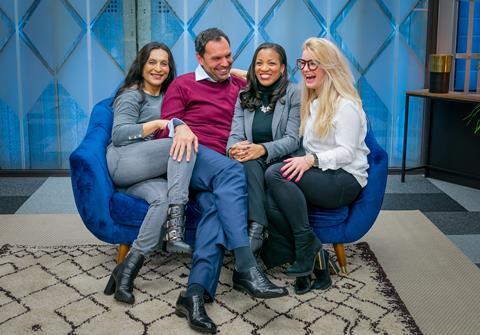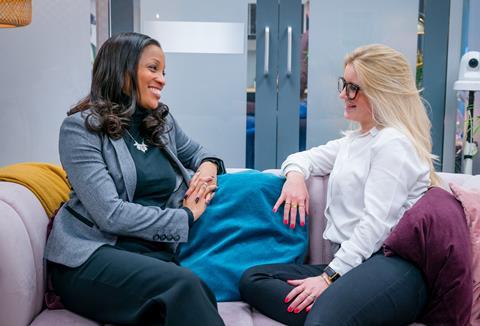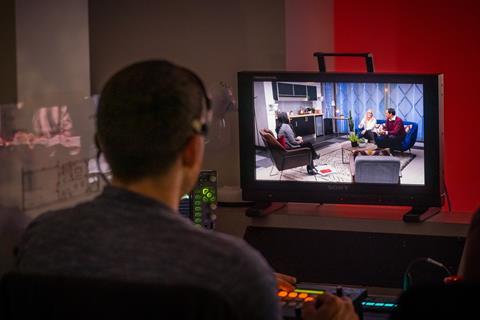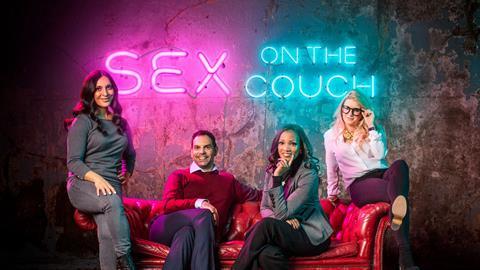Watching couples’ sex therapy sessions was a real privilege and a production challenge, says Caroline Short
Production company BBC Studios
Commissioner Clare Mottershead
Length 6 x 45 minutes
TX Fridays from 26 April, BBC3; 11.25pm, BBC1
Executive producers Caroline Short; Rob Unsworth
Director Dave Symmons
Producers Gemma Nolan
Other key groups BBC Studios Factual Salford
Post-house Fix Facilities
I first pitched this programme as a 20-minute film for another series, called Sex Map of Britain. The commissioner loved it and asked me what I would do to supersize it – and bingo, Sex on the Couch was born.

From there is has grown into an innovative, fixed-rig, factual-entertainment format, following real-life couples as they bring their genuine relationship issues to therapists at a specially created sex and relationship clinic.
Problems in a couple’s sex life are often a symptom of much bigger issues in their relationship, and yet talking about our sex lives can often be very challenging.
This series deals not only with how to increase intimacy in a relationship, but also opens up the conversation around sex and asks couples to get to the heart of what’s causing their problems in the first place.
It felt like a really good time to tackle the tricky conversations, break down a few sexual myths, and help relieve the pressure that young people face around sex.
The audience that BBC3 attracts is young and perhaps more willing to talk about sex in an open and honest way, and indeed the therapists featured in the series largely see clients in their twenties and thirties looking to prevent issues rather than solve ones that are already out of control.

It was really important for the team that the couple’s experience of therapy was real, honest and intimate. The therapists were involved with the entire process from the outset, to ensure that everyone was happy that this was an authentic experience that the couples would benefit from.
From the questionnaire that each couple filled out when they arrived at the clinic, to the homework they were set in between sessions, our therapists were involved.
We also took filming very seriously, making sure that we never interrupted the process. From the moment that a couple was visible outside, they were classed as being on set and there was no interference from the crew.
Our brilliant receptionist Kirsty was key to ensuring that we hit certain format points, putting the couples at ease straight away so that by the time they entered the therapy suite they were relaxed, and all we needed to do was observe.
There’s no denying that casting was tricky. The BBC3 audience is very open to having these conversations, so striking up a discussion wasn’t a problem – but the idea of their parents seeing the series most certainly was. Most people felt reassured by the fact that BBC Studios was making the programme, and that they would be well looked after both before and after the series had gone to air.
My tricks of the trade – Caroline Short
-
Always set out what you’re trying to achieve and how you want the production to run in writing so everyone on the team is clear.

- Always have a Plan A,B, C and D.
- Trust your instinct. If it feels too good to be true then you’re probably right.
- Game face on at all times. No matter how difficult situations can be, never let your emotions get the better of you. If you are calm, your team will be too.
- Remember the good things – productions can be tough environments and it’s too easy to look at what’s gone wrong and dwell on it. Remind yourself and the team how far you’ve come and the stuff you’ve totally nailed. It’s only telly.
Coming up with a new format, and then delivering it, is never easy. Having never produced a fixed rig show before, I knew it would be a learning curve.
We rented an empty office space near Salford which was a real blank canvas and split the space in half to create a clinic and the gallery. Cameras were placed outside the clinic, through the reception, and into the therapy rooms. It needed to flow smoothly and there couldn’t be any blind spots.
There was a lot of time spent working out how the contributors would arrive and leave the clinic. We opted for a car that we could also rig with cameras to capture those off-guard moments. However, when it came to it, the moment they got in the car it felt like a forced atmosphere – the conversations were stilted, and it seemed to brake the bubble in a way we hadn’t expected. We got far better and genuine sync with them simply walking away from the clinic. So the car was binned.

The real challenge here though was creating a totally silent gallery. For anyone that knows me, I found this particularly difficult. With only a thin wall separating the gallery from the clinic, we had to be completely silent throughout filming to avoid breaking the bubble.
From the very first therapy session that we filmed it was clear that anything could happen, and it did. From the everyday technical hiccups, like microphones failing, to unexpected revelations from the couples, we were always on our toes.
Watching as our couples went through the process of therapy was a real privilege. The couples allowed us to witness them at their most vulnerable and observe as they tried to hold their relationships together. Each of them went into this series looking to solve a problem in the bedroom, but beyond that ended up with an overhaul of their relationship – no matter what the outcome.
HELPING SELF-SHOOTING CONTRIBUTORS COMPLETE THEIR ‘HOMEWORK’
Steve McConville
Series producer

The ‘homework’ section of the show was self-shot by our contributors. We wanted this element to give us a really intimate look at their lives away from the slicker production on the rig, so we could get more of a feel for the way their relationship worked in a real-life environment.
We were working to a very tight schedule – each couple would come to the rig once a week for three weeks. This meant a tight turnaround for homework to be shot, wrangled and processed by our team.
The APs working on this section were in the vicinity to manage the contributors and make sure we got the footage into edit, but the footage itself all had to be shot by the couples – usually while the team waited outside in a car.
The couples used iPads so everything coming back to the edit was universal in terms of format, though the content was vastly different for each couple.
It was both fascinating and revealing in the simplest of ways. Some of my favourite moments in the homework sequences came from how the contributors chose to set up a shot – a wide shot of them on opposite ends of a sofa or set up right next to them in bed on a pillow. It always said a lot about the relationship in a way producers couldn’t manufacture.
The intimate nature of filming that the homework section prompted also made for some brilliant moments that were both comedic and incredibly moving. There were a handful of times when one partner interviewed the other, and there isn’t a producer alive that could interview someone as well as their partner could.
It felt like being inviting to listen in on the most private conversations a couple have, which had always been our aim.


































No comments yet